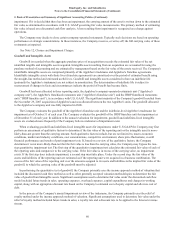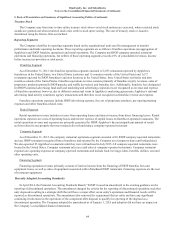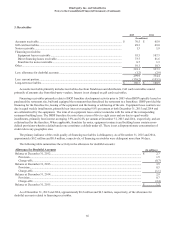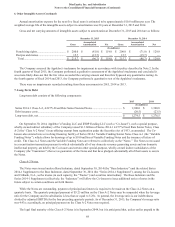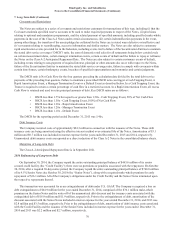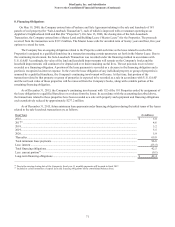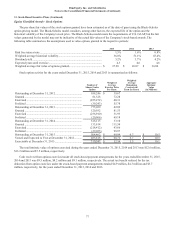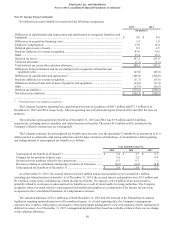IHOP 2015 Annual Report Download - page 90
Download and view the complete annual report
Please find page 90 of the 2015 IHOP annual report below. You can navigate through the pages in the report by either clicking on the pages listed below, or by using the keyword search tool below to find specific information within the annual report.
DineEquity, Inc. and Subsidiaries
Notes to the Consolidated Financial Statements (Continued)
7. Long-Term Debt (Continued)
70
Covenants and Restrictions
The Notes are subject to a series of covenants and restrictions customary for transactions of this type, including (i) that the
Co-Issuers maintain specified reserve accounts to be used to make required payments in respect of the Notes, (ii) provisions
relating to optional and mandatory prepayments, and the related payment of specified amounts, including specified make-whole
payments in the case of the Class A-2 Notes under certain circumstances, (iii) certain indemnification payments in the event,
among other things, the transfers of the assets pledged as collateral for the Notes are in stated ways defective or ineffective and
(iv) covenants relating to recordkeeping, access to information and similar matters. The Notes are also subject to customary
rapid amortization events provided for in the Indenture, including events tied to failure of the Securitization Entities to maintain
the stated debt service coverage (“DSCR”) ratio, the sum of domestic retail sales for all restaurants being below certain levels
on certain measurement dates, certain manager termination events, certain events of default and the failure to repay or refinance
the Notes on the Class A-2 Anticipated Repayment Date. The Notes are also subject to certain customary events of default,
including events relating to non-payment of required interest, principal or other amounts due on or with respect to the Notes,
failure of the Securitization Entities to maintain the stated debt service coverage ratio, failure to comply with covenants within
certain time frames, certain bankruptcy events, breaches of specified representations and warranties and certain judgments.
The DSCR ratio is Net Cash Flow for the four quarters preceding the calculation date divided by the total debt service
payments of the preceding four quarters. Failure to maintain a prescribed DSCR ratio can trigger a Cash Trapping Event, A
Rapid Amortization Event, a Manager Termination Event or a Default Event as described below. In a Cash Trapping Event, the
Trustee is required to retain a certain percentage of cash flow in a restricted account. In a Rapid Amortization Event, all excess
Cash Flow is retained and used to retire principal amounts of debt. Key DSCR ratios are as follows:
• DSCR less than 1.75x but equal to or greater than 1.50x - Cash Trapping Event, 50% of Net Cash Flow
• DSCR less than 1.50x - Cash Trapping Event, 100% of Net Cash Flow
• DSCR less than 1.30x - Rapid Amortization Event
• DSCR less than 1.20x - Manager Termination Event
• DSCR less than 1.10x - Default Event
The DSCR for the reporting period ended December 31, 2015 was 5.40x.
Debt Issuance Costs
The Company incurred costs of approximately $24.3 million in connection with the issuance of the Notes. These debt
issuance costs are being amortized using the effective interest method over estimated life of the Notes. Amortization of $3.1
million and $0.7 million was included in interest expense for the years ended December 31, 2015 and 2014, respectively.
Unamortized debt issuance costs are reported as a direct reduction of the Class A-2 Notes in the consolidated balance sheets.
Maturities of Long-term Debt
The Class A-2 Anticipated Repayment Date is in September 2021.
2014 Refinancing of Long-term Debt
On September 30, 2014, the Company repaid the entire outstanding principal balance of $463.6 million of its senior
secured credit facility (the “Credit Facility”); there were no premiums or penalties associated with the repayment. On October
30, 2014, after a required 30-day notice period, the Company repaid the entire outstanding principal balance of $760.8 million
of its 9.5% Senior Notes due October 30, 2018 (the “Senior Notes”), along with a required make-whole premium for early
repayment of $36.1 million. All of the Company's obligations under the Credit Facility and the Senior Notes terminated upon
the respective repayments thereof.
This transaction was accounted for as an extinguishment of debt under U.S. GAAP. The Company recognized a loss on
debt extinguishment of $64.9 million for the year ended December 31, 2014, comprised of the $36.1 million make-whole
premium on the Senior Notes and the write-off of the unamortized debt discount and the issuance costs associated with the
extinguished debt of $16.9 million and $11.9 million, respectively. Prior to the extinguishment of debt, amortization of the
discount associated with the Senior Notes included in interest expense for the years ended December 31, 2014, and 2013 was
$2.8 million and $3.5 million, respectively. Prior to the extinguishment of debt, amortization of debt issuance costs associated
with the Credit Facility and the issuance of the Senior Notes included in interest expense for the years ended December 31,
2014 and 2013 was $2.2 million and $2.7 million, respectively.


